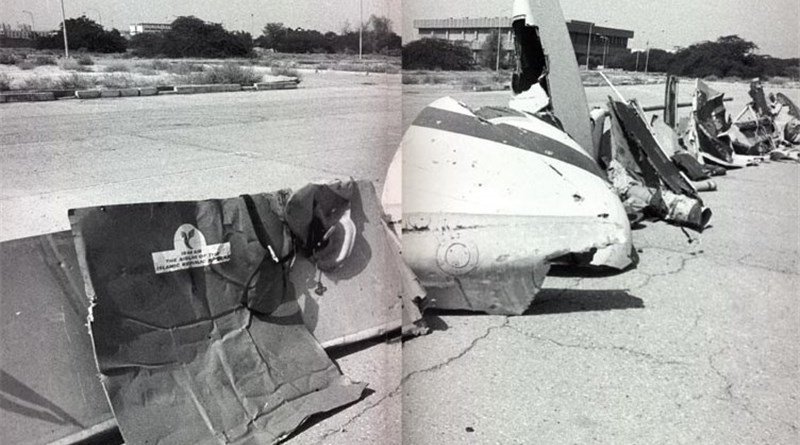Ukrainian Plane Tragedy Challenges Tehran’s Narrative Of 1988 US Shoot-Down Of Iranian Airliner – Analysis
By RFE RL
By Golnaz Esfandiari*
(RFE/RL) — Iran’s unintentional downing of a Ukrainian passenger jet that killed 176 people, including many Iranians, has invoked memories of a similar tragedy: the 1988 U.S. shoot-down of an Iranian plane over the Strait of Hormuz that killed all 290 people on board, including 66 children.
For the past three decades, Iran’s clerical establishment has frequently used that disaster — which came amid tensions between Tehran and Washington — as a propaganda tool for what it calls American “state terrorism” and its disregard for human life while suggesting the U.S. Navy’s shoot-down of Iran Air Flight 655 was intentional.
But in the wake of the January 8 downing of the Ukrainian airliner due to a “human mistake” by the Islamic Revolutionary Guards Corps (IRGC), Tehran’s narrative about the 1988 air tragedy against the United States has been undermined, analysts say.
“It exposes that such mistakes can occur with trained militaries, even Iran’s. Mistakes in war can happen even with the best militaries — both incidents show how devastating such mistakes can be,” says Afshon Ostovar, a professor of national security affairs at the Naval Postgraduate School in California.
Sanam Vakil, deputy director of the Middle East and North Africa program at Chatham House in London, says the downing of the Ukrainian plane challenges “Iran’s three-decade narrative of victimhood around the same American action in 1988.”
The downing of the Ukrainian airliner has led to fury in Iran amid accusations of recklessness by Iranian authorities and a lack of care for the lives of ordinary Iranians at a time of escalating tensions with the United States.
The incident came hours after Tehran launched missile strikes on two Iraqi bases housing U.S. troops in retaliation for the January 3 U.S. assassination of the country’s top military commander, Qassem Soleimani.
Many have questioned why civilian planes were allowed to fly when armed forces were on high alert due to potential U.S. retaliation, while also criticizing Tehran’s delayed admission of guilt that came only three days after the tragedy and amid building Western pressure.
Ostovar says that from now on the Iranian government cannot bring up the U.S. downing of Iran Air Flight 655 without Iranians also thinking about their government’s downing of the Ukrainian plane.
“Downing [Ukrainian] Flight PS752 not only overshadowed any propaganda victory for the IRGC’s missile strike [against U.S. bases in Iraq], it quickly eclipsed any sympathy gained by Soleimani’s assassination,” he told RFE/RL.
Neverthless, Reza Akbari, a program manager at the Institute for War and Peace Reporting, says hard-liners within the Iranian establishment are trying to put the blame on the United States.
“Hard-line pundits on state TV are attempting to spin the incident as a cost of war — a minor price to pay for ensuring the security of the country’s borders. Regime insiders and IRGC officials started to shift the blame toward the U.S. by stating that the Trump administration started the cycle of escalation,” he said.
Speaking earlier this week, Iranian President Hassan Rohani promised an investigation into the “unforgivable error” while Judiciary spokesman Gholamhossein Esmaili said some have been arrested, without providing details.
Akbari says in contrast with hard-liners, Rohani and his government have adopted a mea culpa approach, suggesting that Tehran’s attitude is different from the United States’, which never formally apologized for the 1988 shoot-down.
“They have publicly apologized and believe their admission of guilt shows accountability and bravery,” Akbari added.
Supreme Leader Ayatollah Ali Khamenei — by contrast — has called for national unity and defended the country’s armed forces in the wake of angry protests over the tragic incident.
“The Iranian people love and want resistance to the world powers and no capitulation,” the 80-year-old leader said as he addressed Friday Prayers for the first time in eight years.
Khamenei accused Iran’s enemies of using the plane crash to question the Islamic republic, the armed forces, including the elite Islamic Revolutionary Guards Corps (IRGC), which he said “maintained the security” of Iran.
The July 3, 1988, shoot-down of the Iran Air flight came during the waning days of the Iran-Iraq War and shocked the country, where painful images of the dead and their relatives mourning in agony were widely published in the media and are rebroadcast every year during commemorations.
The United States first denied any knowledge of the incident.
Later, the U.S. Navy said that the Iranian passenger plane — an Airbus en route to Dubai from the Iranian port city of Bandar Abbas — was incorrectly identified as an F-14 jet fighter and brought down with two surface-to-air missiles fired from the USS Vincennes, which had earlier exchanged fire with Iranian boats in the Persian Gulf.
The United States did express regret over the loss of life on the airliner while defending the judgment of USS Vincennes Captain William C. Rogers. The United States also blamed Tehran for allowing “a civilian aircraft loaded with passengers to proceed on a path over a warship engaged in battle.”
Captain Rogers was later awarded the Legion of Merit award, angering Iran and cementing Tehran’s belief that the attack was a warning that Washington was ready to openly side with Iraq in the devastating eight-year-long war.
“If it was a mistake, then why did you give him a medal? If it was a mistake, you should have punished him. Therefore, you are lying,” Iranian parliament speaker Ali Larijani said last year while marking the 31st anniversary of the tragedy.
A report by an international panel of aviation experts published several months after the 1988 tragedy concluded that a series of mistakes by the U.S. Navy had contributed to the shooting down of the Iranian aircraft.
The United States later paid the families of the victims tens of millions of dollars after Tehran filed a complaint with the International Court of Justice.
- Golnaz Esfandiari is a senior correspondent with RFE/RL.

